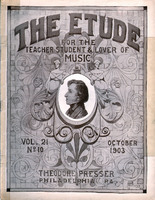J. L. P. — 1. In a choir of twelve, consisting of four sopranos, three altos, two tenors, and three basses, facing the congregation, with the organist’s back to the choir and congregation, with space for five to stand abreast, is there anything positively wrong in the following arrangement?
Organ.
B.A.
B.A.S.S.T.
B.A.S.S.T.
Congregation.
Answer: In the first place, the relative position of the parts is contrary to the established custom; that is, the tenors and basses should change places and the sopranos and altos likewise. As a quartet stands (regardless of their position in front or back of the congregation) the tenor should be at the right of the soprano and the bass at the left of the alto. This would make the above arrangement look from the congregation thus:
A.B.
T.S.S.A.B.
T.S.S.A.B.
Congregation.
In the second place, while the particular conditions of the place may require odd treatment of the seating of the choir, it is generally a bad plan to place one tenor behind another when there are but two, or the basses behind each other. At least two should stand side by side and preferably more in the same row. Two tenors, standing one behind the other, will not get the support from each other that they would get if standing side by side. The same point applies to the altos and basses. A better arrangement of the singers would be:—
T.T.B.B.B.
S.S.A.A.
S.S.A.A.
Congregation.
The gentlemen all in one row, when there are so few, will sing better and their part of the ensemble will be more effective. If four of the singers were to sing as a quartet, the outside tenor and bass could easily step forward and stand outside the soprano and alto, as they ought to stand, with little trouble.
2. If service is announced to commence at 10.30, should the prelude be finished at that time or commence then, and what is the proper length?
Answer: If there is a bell on the church and it tolls until 10.30, the prelude cannot be begun till that time. Otherwise it generally rests with the minister whether the prelude should begin before or at 10.30. From a musical standpoint the service should begin with the prelude, at the time the service is announced. The proper length of the prelude varies with the taste of the authorities in each church. In some churches the pastor and the congregation wish only a short three-minute prelude, while in other churches ten or even fifteen minutes is not too long for their taste. The average length in nonliturgical churches is from four to six minutes. Organ-music is not made to be served by the yard and there should be enough freedom in the time allowed to enable the organist to finish the piece selected. Cutting off the last page or half page of a composition so as to stop at a certain second destroys one’s sense of the artistic, and should be discouraged.
3. Define “feet” as used on organ-stops.
Answer: The number of feet marked on an organ-stop refers literally to the length of the pipe which sounds the lowest note; for instance: “Open Diapason, 8 feet,” means that the pipe of the lowest C is approximately 8 feet long. More practically the number of feet refers to the pitch of the stop. A stop marked “8 feet” sounds the same pitch as the piano, one marked “4 feet” sounds an octave higher, one marked “2 feet” sounds two octaves higher, and one marked “16 feet” sounds an octave lower. If the stop has what we call “stopped pipes,”—that is, the pipes are stopped at the upper ends,—“8 feet” still refers to the pitch of the stop, but the length of the lowest pipe will be but 4 feet. A stopped pipe sounds an octave lower than an open pipe of the same length. The Stopped Diapason is an 8-feet stop, sounding an 8-feet tone, but the lowest pipe is but 4 feet long.



